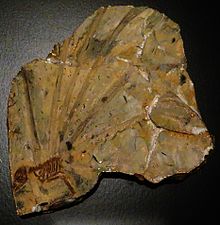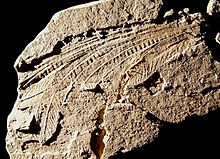
Longisquama

| Longisquama Temporal range: Middle or Late Triassic,
| |
|---|---|

| |
| Cast of the type specimen | |
| Scientific classification | |
| Domain: | Eukaryota |
| Kingdom: | Animalia |
| Phylum: | Chordata |
| Class: | Reptilia |
| Clade: | Neodiapsida |
| Genus: | †Longisquama Sharov, 1970 |
| Species: | †L. insignis
|
| Binomial name | |
| †Longisquama insignis Sharov, 1970
| |
Longisquama is a genus of extinct reptile. There is only one species, Longisquama insignis, known from a poorly preserved skeleton and several incomplete fossil impressions from the Middle to Late Triassic Madygen Formation in Kyrgyzstan. It is known from the type fossil specimen, slab and counterslab (PIN 2548/4 and PIN 2584/5) and five referred specimens of possible integumentary appendages (PIN 2584/7 through 9). All specimens are in the collection of the Paleontological Institute of the Russian Academy of Sciences in Moscow.

Longisquama means "long scales"; the specific name insignis refers to its small size. The Longisquama holotype is notable for a number of long structures that appear to grow from its skin. The current opinion is that Longisquama is an ambiguous diapsid and has no bearing on the origin of birds.

History
Interpretation

Researchers Haubold and Buffetaut believed that the structures were long, modified scales attached in pairs to the lateral walls of the body, like paired gliding membranes.[1] They published a reconstruction of Longisquama with plumes in a pattern akin to gliding lizards like Draco species and Kuehneosaurus latus, allowing it to glide, or at least parachute. Though the reconstruction is now thought to have been inaccurate, versions of it are still often portrayed in modern paleoart.[citation needed]

Other researchers place the scales differently. Unwin and Benton interpreted them as a single, unpaired row of modified scales that run along the dorsal midline.[2] Jones et al. interpreted them as two paired rows of structures that are anatomically very much like feathers, and which are in positions like those of birds' spinal feather tracts.[3] Feather-development expert Richard Prum (and also Reisz and Sues) see the structures as anatomically very different from feathers, and thinks they are elongate, ribbonlike scales.[4][5]

Still other observers (e.g. Fraser in 2006) believe that the structures are not part of Longisquama at all, that they are simply plant fronds that were preserved along with the reptile and were misinterpreted.[6] Buchwitz & Voigt (2012) argue that the structures of Longisquama are not plant remains, because all of the structures except for the last in the holotype PIN 2584/4 are arranged regularly, and that they are not preserved as carbon films, the usual mode of preservation for plants in the Madygen Formation.[7] The only plant from Madygen with similarities to the Longisquama structures is Mesenteriophyllum kotschnevii, but its leaves do not have the distinct hockey-stick shape of the structures attributed to Longisquama.[7]

Description
Integumentary structures

Longisquama is characterized by distinctive integumentary structures along its back. The holotype (specimen PIN 2584/4) is the only known fossil preserving these appendages projecting from the back of an associated skeleton. It has seven appendages radiating in a fan-like pattern, but the tips are not preserved. PIN 2584/9 preserves five complete appendages spaced close together. PIN 2584/6 preserves two long, curved appendage running side by side. Other specimens, such as PIN 2585/7 and FG 596/V/1, preserve only one appendage. These structures are long and narrow throughout most of their lengths, and angle backward near the tip to give the appearance of a hockey stick. The proximal straight section is divided into three longitudinal lobes: a smooth lobe on either side and a transversely ridged lobe running between them. The middle ridged lobe is made up of raised "rugae" and deep "interstices", which Sharov compared to rosary beads. The distal section is thought to be an extension of the middle and anterior lobes of the proximal section. While the anterior lobe widens in the distal section, the posterior lobe of the proximal section narrows until it ends at the base of the distal section. In addition, an "anterior flange" appears about two-thirds the way up the proximal section and continues to the tip of the distal section. Both lobes in the distal section are ridged and separated by a grooved axis. In some specimens, the rugae of either lobe in the distal section line up with each other, while in other specimens they do not. Some specimens have straight rugae projecting perpendicular to the axis, while others have rugae that curve in an S-shape. One specimen of Longisquama, PIN 2584/5, has small spines projecting from the axis of the distal section.[7]

The holotype skeleton shows each structure attaching to a vertebral spine. These anchorage points are visible as raised knobs. The base of each appendage is slightly convex, unlike the flattened shape of the rest of the structure. The convex shape may be evidence that the base of each structure was tubular in life, anchoring like other integumentary structures such as mammalian hair or avian feathers into a follicle. Moreover, the proximity of each structure to its corresponding vertebra suggests that a thick layer of soft tissue, possibly including a follicle, surrounded each base.[7]

Classification
Like the 'long scales', the skeletal features of Longisquama are equally difficult to diagnose. As a result, Longisquama has been related by scientists to many different sauropsid groups.

Sharov determined that it was a "pseudosuchian" (a "primitive" archosaur, but as an archosaur a relatively derived reptile) on the basis of two features: a mandibular fenestra and an antorbital fenestra.[8] Sharov's original description also includes an elongate scapula. Jones et al. see Longisquama as an archosaur, adding to Sharov's two characters a furcula.[3] Olshevsky believes that Longisquama is an archosaur and, moreover, an early dinosaur.[9]

Unwin & Benton did not think it was possible to diagnose the crucial fenestrae; the holes could simply be damage to the fossil.[2] They agreed with Sharov that Longisquama has acrodont teeth and an interclavicle, but instead of a furcula, they saw paired clavicles. These features would be more typical of a member of Lepidosauromorpha, meaning that Longisquama is not an archosaur and thus not closely related to birds. According to a cladistic study by Phil Senter in 2004, Longisquama would be an even more basal diapsid and a member of Avicephala, more closely related to Coelurosauravus.[10]

A 2012 re-examination of the fossil found that the presence of fenestrae in the skull crucial to classification as an archosaur could not be confirmed; in fact, a section of the skull in one of the fossil slabs that had previously been used to justify the presence of antorbital fenestrae does not contain any actual bone. This study concluded that none of the proposed classifications of Longisquama could be confirmed or refuted using the available evidence. The authors of the study tentatively placed Longisquama among the Archosauromorpha as a result of their hypothesis of developmental "deep homology" between its plumes, bird feathers, crocodile scales and pterosaur pycnofibres.[7]

Debate over bird origins


The questions relating to the reptilian classification of Longisquama and to the exact function of the 'long scales' relate to a dismissed proposal that birds are not dinosaurs, but rather descend from earlier archosaurs like Longisquama.

Background
A consensus of paleontologists agrees that birds evolved from theropod dinosaurs. The scenario for this hypothesis is that early theropod dinosaurs were endothermic, and evolved simple filamentous feathers for insulation. These feathers later increased in size and complexity and then adapted to aerodynamic uses. Ample evidence for this hypothesis has been found in the fossil record, specifically for such dinosaurs as Kulindadromeus, Sinosauropteryx, Caudipteryx, Microraptor and many others. Longisquama is thus regarded as a diapsid with strange scales, ambiguous skeletal features and no real significance to bird evolution.

An extreme minority of scientists posit the hypothesis that birds evolved from small, arboreal archosaurs like Longisquama. They see these as ectothermic animals that adapted to gliding by developing elongated scales and then pennaceous feathers. This hypothesis, however, is not supported by cladistic analysis.[11]

References
- ^ Haubold, H. & Buffetaut, E. (1987). "Une novelle interprétation de Longisquama insignis, reptile énigmatique du Trias supérieur d'Asie centrale [A new interpretation of Longisquama insignis, an enigmatic reptile from the Upper Triassic of Central Asia]". Comptes Rendus de l'Académie des Sciences de Paris. 305 (serie II): 65–70.
- ^ a b Prum, R. O./Unwin, D.M., Benton, M.J./Response; Jones, T.D., Ruben, J.A., Maderson, P.F.A., Martin, L.D. (9 March 2001). "Longisquama Fossil and Feather Morphology". Science. 291 (5510): 1899–1902. doi:10.1126/science.291.5510.1899c. PMID 11245191. S2CID 34144897.
{{cite journal}}: CS1 maint: multiple names: authors list (link) - ^ a b Jones, T.D.; Ruben, J.A.; Martin, L.D.; Kurochkin, E.; Feduccia, A.; Maderson, P.F.A.; Hillenius, W.J.; Geist, N.R.; Alifanov, V. (23 June 2000). "Nonavian Feathers in a Late Triassic Archosaur". Science. 288 (5474): 2202–2205. Bibcode:2000Sci...288.2202J. doi:10.1126/science.288.5474.2202. PMID 10864867.
- ^ Prum, R.O. (2002). "Are current critiques of the theropod origin of birds science? Rebuttal to Feduccia". The Auk. 120 (2): 550–561. doi:10.1642/0004-8038(2003)120[0550:ACCOTT]2.0.CO;2. ISSN 0004-8038.
- ^ Reisz, R.R.; Sues, H.-D. (23 November 2000). "The "Feathers" of Longisquama". Nature. 408 (6811): 428. doi:10.1038/35044204. PMID 11100716. S2CID 4425631.
- ^ Fraser, N. (2006). Dawn of The Dinosaurs: Life in the Triassic. Bloomington: Indiana University Press. ISBN 978-025-334-3.
- ^ a b c d e Buchwitz, M.; Voigt, S. (2012). "The dorsal appendages of the Triassic reptile Longisquama insignis: reconsideration of a controversial integument type". Paläontologische Zeitschrift. 86 (3): 313–331. doi:10.1007/s12542-012-0135-3. S2CID 84633512.
- ^ Sharov, A.G. (1970). "A peculiar reptile from the lower Triassic of Fergana". Paleontologicheskii Zhurnal (1): 127–130.
- ^ Olshevsky, G. 1991. A Revision of the Parainfraclass Archosauria Cope, 1869, Excluding the Advanced Crocodylia. Mesozoic Meanderings, 2: 196 pp.
- ^ Senter, P. (2004). "Phylogeny of the Drepanosauridae (Reptilia: Diapsida)". Journal of Systematic Palaeontology. 2 (3): 257–268. doi:10.1017/S1477201904001427. S2CID 83840423.
- ^ Padian, Kevin (2004). "Basal Avialae". In Weishampel, David B.; Dodson, Peter; Osmólska Halszka (eds.). The Dinosauria (Second ed.). Berkeley: University of California Press. pp. 210–231. ISBN 0-520-24209-2.
Further reading
- Feduccia, A.; Lingham-Soliar, T. & Hinchliffe, J.R. (2005). "Do feathered dinosaurs exist? Testing the hypothesis on neontological and paleontological evidence". Journal of Morphology. 266 (2): 125–66. doi:10.1002/jmor.10382. PMID 16217748. S2CID 15079072.
- Martin, L. D. (2008). "Origin of avian flight- a new perspective". Oryctos. 7: 45–54.
- Stokstad E. (23 June 2000). "Feathers, or flight of fancy?". Science. 288 (5474): 2124–2125. doi:10.1126/science.288.5474.2124. PMID 10896578. S2CID 82060725.
- Sebastian Voigt; Michael Buchwitz; Jan Fischer; Daniel Krause & Robert Georgi (2009). "Feather-like development of Triassic diapsid skin appendages". Naturwissenschaften. 96 (1): 81–86. Bibcode:2009NW.....96...81V. doi:10.1007/s00114-008-0453-1. PMID 18836696. S2CID 10104426.
External links
- A critique of Martin 2004 by Mickey Mortimer
- A critique of Feduccia et al. 2005 by Mickey Mortimer
- A newspaper article on Longisquama plumes discovered by Kurochkin and Martin
- Photographs of the type specimen, from Jones et al. 2000
- Photograph of the type specimen, from the twitter account of Nickolay Gnezdilov
- Photograph of the type specimen, from the twitter account of Christian Kammerer
See what we do next...
OR
By submitting your email or phone number, you're giving mschf permission to send you email and/or recurring marketing texts. Data rates may apply. Text stop to cancel, help for help.
Success: You're subscribed now !






